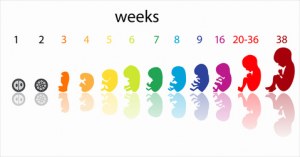Human normal fetal brain

A complete biological bank (tissue sections, DNA, RNA, proteins) from differents structures of fetal brain.
/fichiers/Fotolia_32651771_XS.jpg
Total Brain
Tissue Sections
DNA
RNA
Proteins
Other
BRAIN STEM
In vertebrate anatomy the brainstem (or brain stem) is the posterior part of the brain, adjoining and structurally continuous with the spinal cord. It is usually described as including the medulla oblongata (myelencephalon), pons (part of metencephalon), and midbrain (mesencephalon). Less frequently, parts of the diencephalon are included. The brain stem provides the main motor and sensory innervation to the face and neck via the cranial nerves. Though small, this is an extremely important part of the brain as the nerve connections of the motor and sensory systems from the main part of the brain to the rest of the body pass through the brain stem. This includes the corticospinal tract (motor), the posterior column-medial lemniscus pathway (fine touch, vibration sensation and proprioception) and the spinothalamic tract (pain, temperature, itch and crude touch). The brain stem also plays an important role in the regulation of cardiac and respiratory function. It also regulates the central nervous system, and is pivotal in maintaining consciousness and regulating the sleep cycle. The brain stem has many basic functions including heart rate, breathing, sleeping and eating.
Tissue Sections
DNA
Proteins
CEREBELLUM
The cerebellum (Latinfor little brain) is a region of the brain that plays an important role in motor control. It may also be involved in some cognitive functions such as attention and language, and in regulating fear and pleasure responses, but its movement-related functions are the most solidly established. The cerebellum does not initiate movement, but it contributes to coordination, precision, and accurate timing. It receives input from sensory systems of the spinal cord and from other parts of the brain, and integrates these inputs to fine tune motor activity. Because of this fine-tuning function, damage to the cerebellum does not cause paralysis, but instead produces disorders in fine movement, equilibrium, posture, and motor learning.
Tissue Sections
RNA
Proteins
DIENCEPHALON
The diencephalon ("interbrain") is the region of the vertebrate neural tube which gives rise to posterior forebrain structures. In development, the forebrain develops from the prosencephalon, the most anterior vesicle of the neural tube which later forms both the diencephalon and the telencephalon. In adults, the Diencephalon appears at the upper end of the brain stem, situated between the cerebrum and the brain stem. It is made up of four distinct components: the thalamus, the subthalamus, the hypothalamus and the epithalamus.
Tissue Sections
DNA
RNA
Proteins
FRONTAL LOBE
The frontal lobe is an area in the brain of mammals, located at the front of each cerebral hemisphere and positioned anterior to (in front of) the parietal lobe and superior and anterior to the temporal lobes. It is separated from the parietal lobe by a space between tissues called the central sulcus, and from the temporal lobe by a deep fold called the lateral (Sylvian) sulcus. The precentral gyrus, forming the posterior border of the frontal lobe, contains the primary motor cortex, which controls voluntary movements of specific body parts.
Tissue Sections
DNA
RNA
Proteins
OCCIPITAL LOBE
The occipital lobe is the visual processing center of the mammalian brain containing most of the anatomical region of the visual cortex. The primary visual cortex is Brodmann area 17, commonly called V1 (visual one). Human V1 is located on the medial side of the occipital lobe within the calcarine sulcus; the full extent of V1 often continues onto the posterior pole of the occipital lobe. V1 is often also called striate cortex because it can be identified by a large stripe of myelin, the Stria of Gennari. Visually driven regions outside V1 are called extrastriate cortex. There are many extrastriate regions, and these are specialized for different visual tasks, such as visuospatial processing, color discrimination and motion perception. The name derives from the overlying occipital bone, which is named from the Latin oc- + caput, "back of the head".
Tissue Sections
DNA
RNA
Proteins
PARIETAL LOBE
The parietal lobe is a part of the brain positioned above (superior to) the occipital lobe and behind (posterior to) the frontal lobe. The parietal lobe integrates sensory information from different modalities, particularly determining spatial sense and navigation. For example, it comprises somatosensory cortex and the dorsal stream of the visual system. This enables regions of the parietal cortex to map objects perceived visually into body coordinate positions. The name derives from the overlying parietal bone, which is named from the Latin paries-, wall.
Tissue Sections
DNA
RNA
Proteins
TEMPORAL LOBE
The temporal lobe is a region of the cerebral cortex that is located beneath the Sylvian fissure on both cerebral hemispheres of the mammalian brain. The temporal lobe is involved in auditory perception and is home to the primary auditory cortex. It is also important for the processing of semantics in both speech and vision. The temporal lobe contains the hippocampus and plays a key role in the formation of long-term memory.
Tissue Sections
DNA
RNA
Proteins

